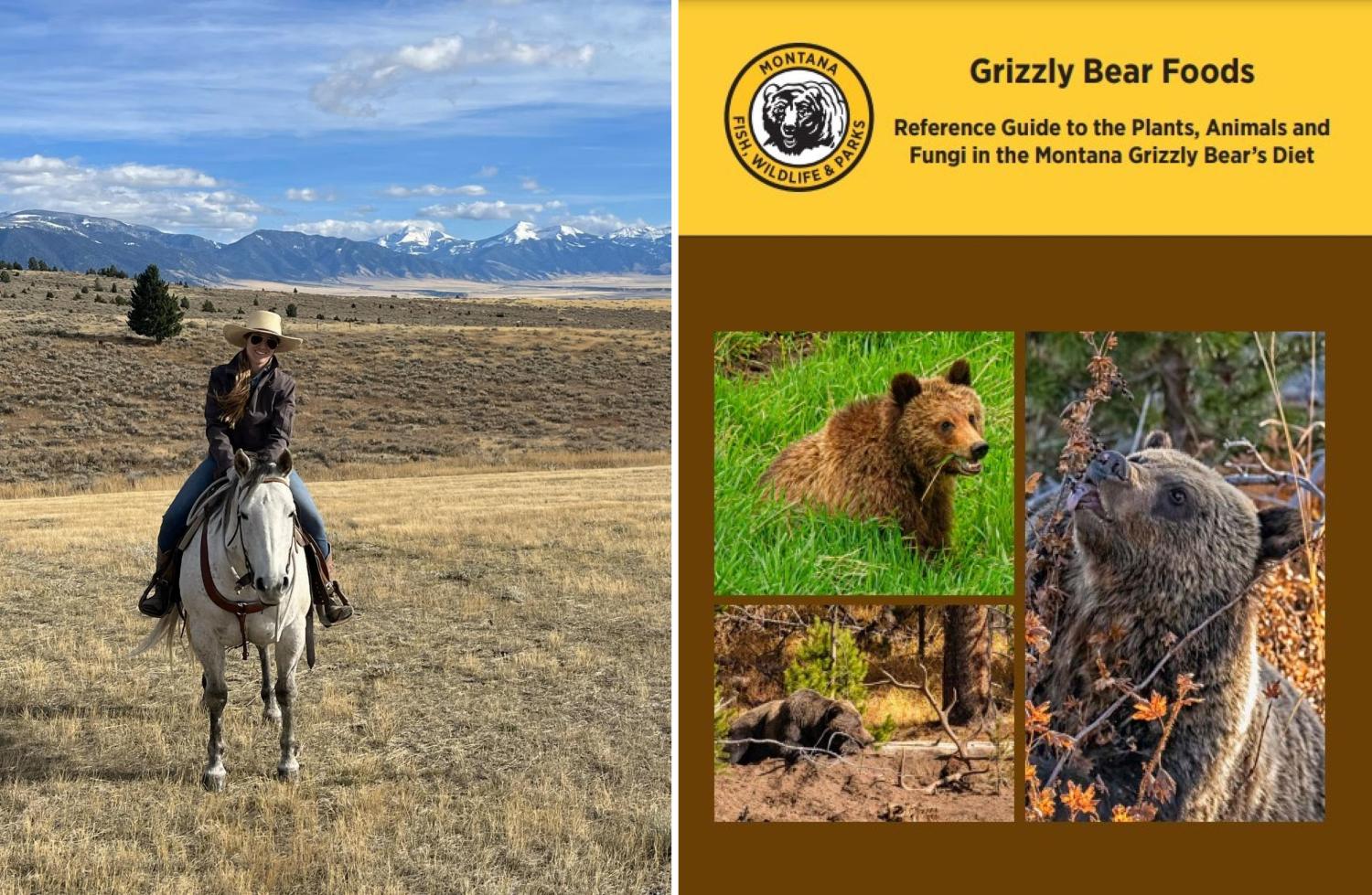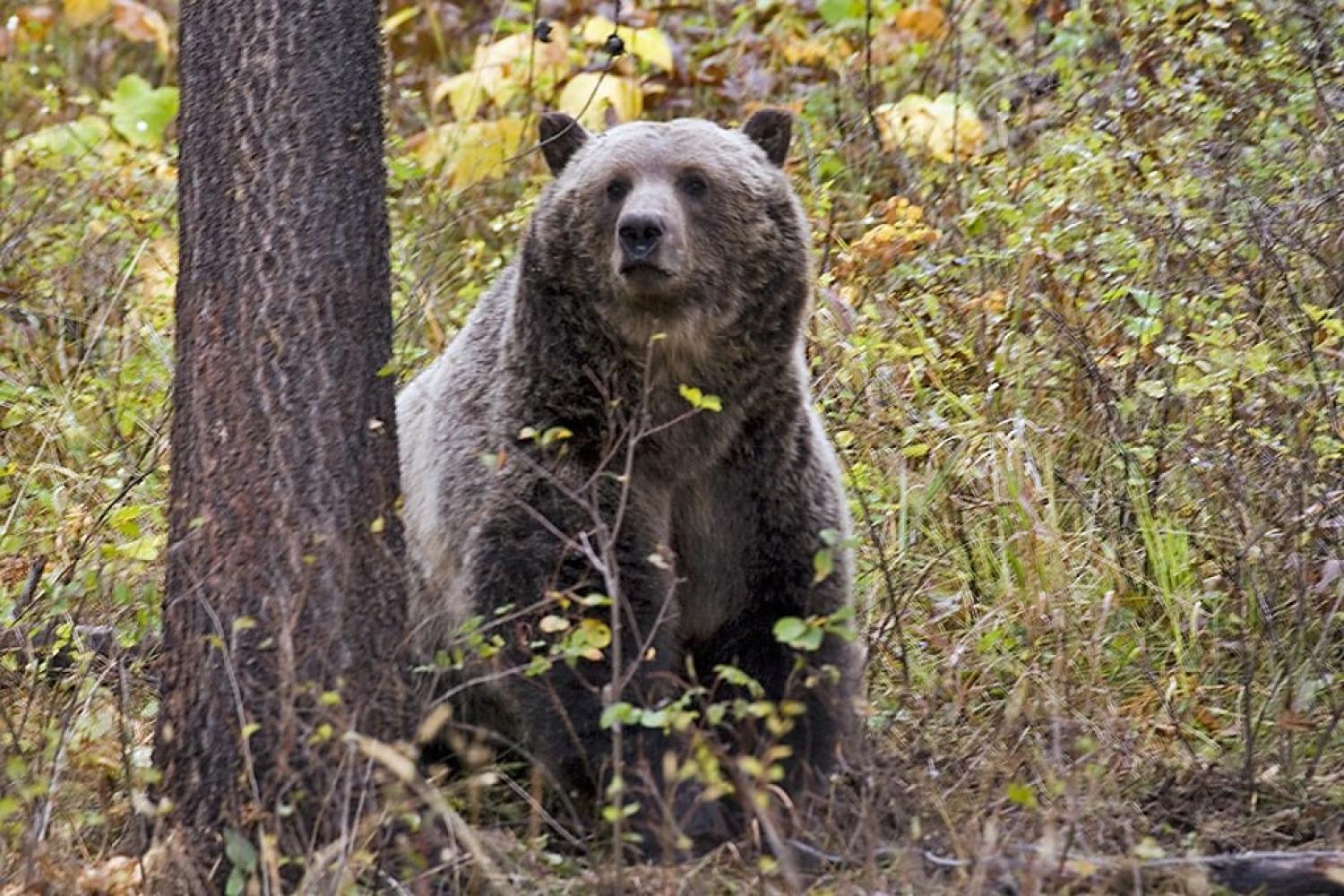Learning the recipe for grizzly gourmet
CU Boulder anthropology PhD candidate Sabrina Bradford has been learning what’s on the menu for grizzlies in Montana
If you’re ever heading to Montana’s backcountry, you’d be hard pressed to find a better guide than Sabrina Bradford, a University of Colorado Boulder PhD candidate in biological anthropology.
Bradford has spent more than a decade in the area’s countryside, mostly on horseback, studying conflict between humans and wildlife, social-ecological systems, livestock damage and the grizzly-bear diet.
Lately she’s been getting noticed for that last item.

Anthropology PhD candidate Sabrina Bradford (left) wrote Grizzly Bear Foods: Reference Guide to the Plants, Animals, and Fungi in the Montana Grizzly Bear's Diet, published by Montana Fish, Wildlife and Parks.
This fall, Montana Fish, Wildlife and Parks published her new 100-page book, Grizzly Bear Foods: Reference Guide to the Plants, Animals, and Fungi in the Montana Grizzly Bear's Diet, which will be part of the state’s “bear aware” education program for the public in 2025.
“I saw a lot about how grizzlies used the landscape,” says Bradford, who sometimes has ridden 20 miles a day in the backcountry doing research and working as a guide and bear education specialist. “I took plenty of photos of grizzly bear signs―areas where it looked like a tiller had rolled through the soil, over rocks and torn up trees. I wanted people to be able to see the landscape similar to the way I did. It’s really important to me that the public understands what bears are actually doing on the landscape.”
Of course, that landscape is a massive buffet for grizzlies, whose four food groups are plants, animals, fungi and trash from humans. A few specific examples of their diet: grasses, shrubs, seeds and fruits of trees, mushrooms, ducks, bird eggs, trout, salmon, squirrels, beaver, moose, bison, elk, deer, bighorn sheep, ants, termites and bees.
Bradford, who graduates this month, says grizzlies serve an important role as seed dispersers within the ecosystem there, and many of the shrubs grizzlies eat produce berries (e.g. huckleberry, raspberry, serviceberry, grouse whortleberry, buffaloberry) that are dispersed via scat.
‘Pretty cool animals’
“Bears are pretty cool animals,” Bradford says. “They have incredible spatiotemporal memory [they can recall where and when food was presented], and they use social learning. Mom teaches her cubs food acquisition strategies. This is key for people to understand, those who question why cubs were removed from an area as well as when the mother is removed for dumpster diving. She’s just teaching her cubs how to access a reliable food resource.”
Bears are also not above stealing other animals’ food stash, an activity called kleptoparasitism.

Grizzly bears sometimes steal other animals' food stashes, an act called kleptoparasitism. (Photo: Montana Fish, Wildlife and Parks)
“People who hike in grizzly country with their dogs off the leash say their dog will protect them. That doesn’t really work,” Bradford explains. “Kleptoparasitism is one of the food-source acquisition strategies grizzlies use, and they’ll steal food from packs of wolves. Wolves will yield to grizzly bears, and your dog is nowhere near as tough as a pack of wolves.”
Bradford says while she’s seen many grizzlies, she’s never had to use her bear spray. Her advice to avoid attacks: “Realize that the human voice is the most powerful deterrent out there, not radios or bear bells. Talk loud in areas of low visibility so the bears can hear you coming. It’s critical to understand that you shouldn’t surprise a bear, that they’ll do anything to protect their cubs. And be aware of magpies or ravens in the forest because they’re a sign you might be hiking up on a carcass.”
And while grizzlies’ sense of hearing is strong, their sense of smell is astounding. “The size of the olfactory bulb, the part of the brain that processes scent information in grizzlies, is more than five times larger than humans’ olfactory bulb.” She advises people to sleep in clothes they haven’t cooked in: “Just because you can’t smell food on your clothes doesn’t mean bears can’t.”
Bradford adds that there is a common misunderstanding that grizzlies are looking to wipe out the first person they see and that livestock producers want to kill all grizzlies.
“That isn’t true,” she says. “Yes, livestock loss to grizzlies does occur, but ranchers I interviewed said over 80% of the grizzlies out there never cause any trouble. And other ranchers reported that it’s common to see grizzlies grazing grass in the same fields that the cattle use.”
She recalls one rancher telling her, “’Wildlife is embedded deep in our traditions. We don't hate grizzly bears; they're amazing animals. I don't want to give up all I have to the grizzly bear but I'm willing to share it.’”
Did you enjoy this article? Subscribe to our newsletter. Passionate about anthropology? Show your support.

